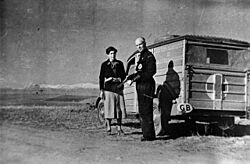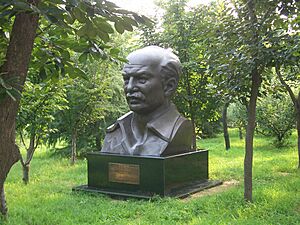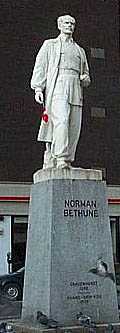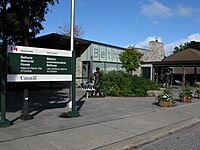Norman Bethune facts for kids
Quick facts for kids
Norman Bethune
|
|||||||
|---|---|---|---|---|---|---|---|
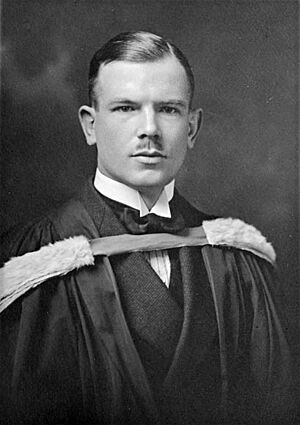
Bethune in 1916
|
|||||||
| Born |
Henry Norman Bethune
March 4, 1890 Gravenhurst, Ontario, Canada
|
||||||
| Died | November 12, 1939 (aged 49) Tang County, Hebei, China
|
||||||
| Education | University of Toronto | ||||||
| Occupation | Physician, surgeon | ||||||
| Employer | Royal Victoria Hospital, Hôpital du Sacré-Coeur de Montréal | ||||||
| Known for | Developing mobile medical units, surgical instruments and a method for transporting blood for transfusions | ||||||
| Political party | Communist Party of Canada Chinese Communist Party |
||||||
| Chinese name | |||||||
| Chinese | 白求恩 | ||||||
|
|||||||
| Transcription of full name | |||||||
| Traditional Chinese | 亨利·諾爾曼·白求恩 | ||||||
| Simplified Chinese | 亨利·诺尔曼·白求恩 | ||||||
|
|||||||
Henry Norman Bethune was a Canadian doctor and surgeon. He was born on March 4, 1890, and passed away on November 12, 1939. Bethune became famous for his work as a frontline surgeon during the Spanish Civil War. He also helped the Chinese Communist Party's army during the Second Sino-Japanese War.
Bethune brought modern medical care to rural China. He treated both sick villagers and wounded soldiers. He created a mobile blood-transfusion service for soldiers in Spain. Sadly, he died from blood poisoning after accidentally cutting his finger while operating on wounded Chinese soldiers.
The leader of China, Mao Zedong, respected Bethune greatly. He wrote a special message honoring Bethune after his death. Norman Bethune is still honored in China today.
Contents
Early Life and Family Background
Norman Bethune was born in Gravenhurst, Ontario, Canada. His family had a long history in Canada. His great-great-grandfather, John Bethune, helped start the first Presbyterian church in Montreal.
His great-grandfather, Angus Bethune, was a fur trader. He explored much of Canada's North West. Norman's grandfather, Norman Bethune, Sr., was also a doctor. He helped start a medical school in Toronto.
Norman's parents were very religious. He grew up feeling like he needed to achieve great things.
Becoming a Doctor

Bethune started studying at the University of Toronto in 1909. He first studied physiology and biochemistry. He took a break in 1911 to work as a teacher in a remote lumber camp.
In 1914, World War I began. Bethune paused his medical studies again to join the Royal Canadian Army Medical Corps. He served as a stretcher-bearer in France. He was injured and sent back to Canada to recover. After healing, he finished his medical degree in 1916.
After the war, Bethune joined the Royal Navy as a surgeon. He specialized in children's diseases. He later earned a special qualification in surgery in Edinburgh, Scotland.
In 1926, Bethune became very sick with tuberculosis. This was a serious lung disease. The usual treatment was a lot of bed rest. But Bethune read about a new treatment called pneumothorax. This involved collapsing the diseased lung to help it heal. His doctors thought it was too risky, but Bethune insisted. He had the operation and made a full recovery.
From 1928 to 1936, Bethune became a skilled thoracic surgeon. This means he specialized in chest surgery. He even invented or improved many surgical tools. His most famous invention was the Bethune Rib Shears, which are still used today.
Helping People and Political Ideas
Bethune cared deeply about how sickness affected poor people. During the 1930s, a time of great economic hardship, he often treated poor patients for free in Montreal. He believed that medical care should be available to everyone, not just those who could pay.
He was an early supporter of universal health care, where everyone gets medical care no matter their income. He even visited the Soviet Union in 1935 to see their free healthcare system. During this time, he became a member of the Communist Party of Canada.
Service in the Spanish Civil War
In 1936, the Spanish Civil War broke out. Bethune quickly went to Spain to help the government forces. He arrived in Madrid in November.
He realized that wounded soldiers needed blood transfusions right away. So, he came up with an idea: a mobile blood transfusion service. He would collect blood from civilians and take it to wounded soldiers near the front lines. His unit, called the Servicio canadiense de transfusión de sangre, was very important. It covered a large area and saved many lives.
Bethune returned to Canada in 1937. He gave speeches to raise money and find volunteers to help in Spain.
Work in China
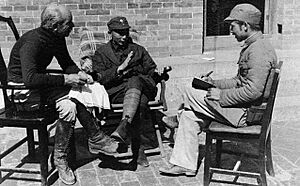
In January 1938, Bethune traveled to China. He joined the Chinese Communists, led by Mao Zedong. He helped organize medical services for the army and the local people.
In China, Bethune performed emergency surgeries on wounded soldiers right on the battlefield. He also trained Chinese doctors, nurses, and medical helpers. He treated everyone who needed help, no matter which side they were on.
Bethune believed that medicine should not be about making money. He said, "Medicine, as we are practising it, is a luxury trade. We are selling bread at the price of jewels." He wanted to make medicine fair and available to everyone.
In the summer of 1939, Bethune became a medical advisor to a military district. While working, he accidentally cut his finger on October 29, 1939. Three days later, the wound reopened and became infected. Because he was likely weak from not eating enough, he got a serious infection called septicaemia. He died on November 12, 1939.
Norman Bethune's Legacy
In Canada
Even though he was not well-known in Canada during his life, Bethune is now a national hero. In 1973, the Canadian government bought his birthplace in Gravenhurst. It was turned into the Bethune Memorial House, a National Historic Site of Canada.
Many things in Canada are named after him. There is a high school called Dr Norman Bethune Collegiate Institute in Scarborough. The University of Toronto holds an annual medical conference in his honor. In 1998, he was added to the Canadian Medical Hall of Fame.
The city of Montreal has a public square and a statue dedicated to him. In 1990, Canada and China even issued postage stamps with his picture to celebrate 100 years since his birth.
In China
In China, Norman Bethune is extremely famous. Chairman Mao Zedong wrote a special essay called In Memory of Norman Bethune. This essay described Bethune's last months in China. For many years, this essay was required reading for all elementary school students in China.
Mao Zedong praised Bethune's selfless spirit. He said, "Comrade Bethune's spirit, his utter devotion to others without any thought of self, was shown in his great sense of responsibility in his work and his great warm-heartedness towards all comrades and the people."
Many statues of Bethune have been built across China. He is buried in the Revolutionary Martyrs' Cemetery in Shijiazhuang. This is a very important place.
A major medical university in China, the Norman Bethune University of Medical Sciences, was named after him. It was founded based on a medical school he helped start. There are several statues of him at this university.
China also gives out the Bethune Medal. This is the highest medical honor in China. It is given to doctors who show outstanding contributions and a great humanitarian spirit.
In Film and Books
Norman Bethune's life has been shown in many films and books. There have been several movies about him, including Doctor Bethune (1964) and Bethune: The Making of a Hero (1990), starring Donald Sutherland.
The National Film Board of Canada made a documentary about him in 1964. In 2006, Chinese television produced a 20-part drama series about his life.
Many books have been written about Bethune. These include biographies and even fictional stories inspired by his life. He is a character in the novel Los pacientes del doctor García, where he teaches blood transfusion techniques.
Images for kids
See also
 In Spanish: Norman Bethune para niños
In Spanish: Norman Bethune para niños
- Bethune Memorial House
- Canada–China relations
- Dwarkanath Kotnis
- Edgar Snow
- Christopher Plummer, distant relative of Bethune
- Jean Ewen, a Canadian nurse who worked with Bethune in China
- John Rabe
- Joseph Terence Montgomery Needham


